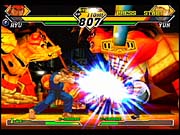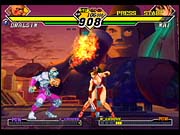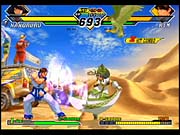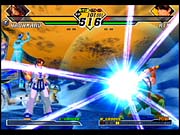There's really not much new in Capcom vs. SNK 2 EO, the first 2D fighting game for the GameCube and the bazillionth fighting game featuring Ken. This particular version of the game is basically identical to last year's Capcom vs. SNK 2 for the PS2, which was basically identical to Capcom vs. SNK 2 for the Dreamcast, which was a perfect port of the arcade version of the game, which was closely based on the 2-year-old original. All these games have pitted the characters from Capcom's and SNK's many popular fighting games from over the years against each other. Two years ago, the idea of a Capcom vs. SNK game was nothing short of unthinkable, as the two companies were seen as close competitors. Now it's a reality, and the novelty is long gone. What's left is by all means a solid fighting game, filled with many likable characters. Unfortunately, the GameCube's controller just wasn't designed to work well with a game like this, and it cripples your ability to play and enjoy it, regardless of a new control scheme designed for Nintendo's console.

The only real difference between this and older versions of Capcom vs. SNK 2 is the presence of a new optional control scheme exclusively designed for the GameCube. This is an innovative but ultimately misguided attempt to address the fact that the stock GameCube controller is completely unfit for use with a traditional fighting game. For starters, in the new control scheme, you use the GameCube's left analog stick to move your character around, but unfortunately, the analog stick isn't nearly as precise as a digital pad--or a digital arcade stick, for that matter. The controller's two shoulder buttons function as pressure-sensitive punch and kick buttons, allowing you to execute basic attacks haphazardly at best. This bizarre throwback to the giant rubber-coated pressure-sensitive punch and kick buttons from the original Street Fighter arcade game is perhaps amusing, but the amusement ends as soon as you start trying to throw quick flurries of jabs or properly time your roundhouse kicks.
Yet the biggest deal with the new controls is that the right analog stick lets you easily perform all your character's various special moves, which normally would be executed with relatively complex combinations of controller motions and button presses. For example, Russian wrestler Zangief's spinning pile driver, normally requiring a full-circle motion on a joystick or directional pad, is now executed simply by pressing forward on the analog stick. Charge moves such as Guile's sonic boom, which normally require players to press and hold a button or controller direction, now require no charging. Super moves are executed just as easily. Arguably, this grossly simplified control scheme opens up some new tactical possibilities--if you've ever wondered how a computer-controlled Blanka could execute his roll attack while walking forward, well, now you can actually pull off such outrageous stunts. It also saps most of the fun out of the game and makes competitive play pointless. The character balance gets completely thrown off, as relatively hard-to-execute moves are no longer hard to execute, making some of them--like that spinning pile driver--obscenely overpowered. The presence of the traditional control scheme mitigates these problems somewhat, but the GameCube controller doesn't wear it well. That tiny, inconveniently located directional pad is cumbersome to use with this game, and the placement of the other controller buttons is just as bad.
It's somewhat sad that the biggest problem with Capcom vs. SNK 2 EO isn't even really intrinsic to the core game. The good news is, there are a few ways to get around the awful controls, if you desperately want to play Capcom vs. SNK 2 on your GameCube. There's at least one good arcade-style GameCube-compatible joystick available, the X-arcade, and at least one other such peripheral is on the horizon, though currently no standard six-button gamepads are either available or planned for the system. Alternately, you could spend money on converter cables that let you hook up a PlayStation 2 gamepad to your GameCube. These solutions are viable, but costly and awkward, effectively making Capcom vs. SNK 2 EO a lot more expensive and inconvenient to play than it should be.

As a sequel, Capcom vs. SNK 2 adds some new characters, some new moves, some new game mechanics, some new backgrounds, and some new music. However, there's also a lot of the same old graphics, same old sounds, and same old gameplay. The impact of the changes made to the game will depend on how serious you are about your 2D fighters, and given the control issues, it seems ridiculous to discuss the subtler aspects of the gameplay at length.
There are about 40 different characters available in the game, though of course not all of them are completely unique. Some of the better additions in this sequel include Eagle, the British stick fighter who dates all the way back to the original Street Fighter game, and Haohmaru, the cocky sword-wielding samurai from SNK's Samurai Shodown series, whose katana would presumably give him an unfair advantage. Fortunately, other characters have no problem deflecting Haohmaru's long, slow slashes with their forearms. Other notable additions include the kung fu fighter Yun, from Street Fighter III, and Rock Howard, the bastard son of Geese Howard who first appeared in SNK's Fatal Fury: Mark of the Wolves. Some of the other new characters, such as the over-the-hill martial artist Ryuhaku Todo, from SNK's Art of Fighting, and Maki, a rip-off of SNK's Mai Shiranui who appeared in the sequel to Final Fight, are surprising additions to the lineup, but not necessarily good ones. Capcom and SNK fans alike will probably find that they can think of a few equally rare characters they would have rather seen in the game.
The original Capcom vs. SNK let you unlock an additional version of each character that sported a different arsenal of special moves. Capcom vs. SNK 2 basically merges these "EX" characters with their standard counterparts, making for characters who for the most part have more moves and more options and are therefore generally more interesting to play. Capcom vs. SNK 2 also shows that its designers are being rather wishy-washy in deciding just how many attack buttons you can use. The Street Fighter series famously used the six-button layout of three punches and three kicks. On the other hand, NeoGeo games have always used just four buttons, and the original Capcom vs. SNK took this streamlined approach. But now, the sequel throws in with Capcom's old style.

Aside from all the characters, perhaps the most notable gameplay feature in Capcom vs. SNK 2 is the availability of six different fighting styles to choose from, compared with two in the original. The game calls these "grooves," and they're designed to mimic the gameplay styles of previous Capcom and SNK fighting games. Whether your character can perform a quick forward hop or a full run, block in midair, quickly recover from a knockdown, counter from the blocking position, and much more is governed by which groove you select. As in the original Capcom vs. SNK, you choose a team of fighters, and the groove you select applies to all of them.
The newly added grooves are interesting. The Street Fighter III-style "P" groove lets you parry attacks as in that game--you can tap forward as you're about to get hit, and you'll absorb the blow and have a moment to counter. The Samurai Shodown-style "K" groove displays a gauge that increases as your character sustains damage. When it's full, your character is in an enraged state (his or her skin turns all red), and you can dish out much more pain. This groove also gets the "just defended" system from Fatal Fury: Mark of the Wolves, which works just like parrying, only you tap backward instead of forward as you're attacked. If nothing else, the P and K grooves are fun additions to the game, though they're not as versatile as the more-conventional styles you may be accustomed to from games like Street Fighter Alpha II or King of Fighters '97. The other grooves have basically been left unchanged.
The core gameplay of Capcom vs. SNK 2 is much like that of the first game. The action still feels a bit flat--it doesn't help that the sound effects of punches and kicks aren't very good, but more importantly, the game's timing isn't quite like how you might remember it in classic 2D fighters. There's not much of a stun pause when a hit connects, making most of the attacks seem very light and the timing for combos somewhat too abrupt. The ranges of normal and special moves don't necessarily correspond to what the character sprites look like they're doing. Overall, though, Capcom vs. SNK 2 certainly plays well--in theory--but it doesn't play so differently from or any better than various 2D fighting games from years past.
Capcom vs. SNK 2 looks about the same as the original. It's been said before, but some of those characters look simply archaic at this point--one-eyed Sagat hasn't changed since Street Fighter Alpha from 1995, and Morrigan, the succubus from the Darkstalkers series, dates back even earlier. Some of the new characters look pretty good and are smoothly animated--in particular, Eagle and Haohmaru look like the imposing fighters they're supposed to be. Others, such as the silly duo of Chang and Choi, the two Korean ex-cons from the King of Fighters series, look poor and use the bland, comical art style used for some of the uglier Street Fighter Alpha characters, such as Blanka and Balrog the boxer (who are as ugly as ever in Capcom vs. SNK 2). The game's biggest graphical problem is still that the art style throughout is so inconsistent from character to character.

At least the characters all seem to blend in well with the game's attractive backgrounds, which combine fully 3D scenery with nicely drawn 2D artwork and are filled with some really obscure references to some of Capcom's and SNK's older games. It's too bad that the tastefully done introduction animations used for the original Capcom vs. SNK stages are nowhere to be found in the sequel. Likewise, there's no real semblance of a story and no real character endings. Capcom vs. SNK 2 recycles most of the speech and sound effects from the first game, and the all-new music mostly consists of the same sort of forgettable but occasionally grating dance beats found in the original. However, a couple of these tracks are quite good and actually use vocals to good effect. But you'll want to turn off most of the vocals, all the more so because of the game's irritating albeit fluently English-speaking announcer.
Between its release in arcades and for the Dreamcast and PS2, Capcom vs. SNK 2 has already proven to be a successful sequel with fans of the original, as well as with many fans of both companies' previous efforts. So, chances are good that most everyone who'd appreciate Capcom vs. SNK 2 has already played it. The new GameCube version's attempts at simplifying the controls, both to make the game playable on the system and also to make the game accessible to a wider audience, deserves credit only for the effort. In practice, the controls effectively eliminate much of the unique tactical challenge that can make fighting games so rewarding. Traditional fighting games may not be so popular anymore, but it isn't because they're hard to play. It's because they're all stuck in a rut, following the same exact cookie-cutter pattern that's appealing to fewer and fewer people as time goes by. Capcom vs. SNK 2 for the GameCube misguidedly tries to broaden its appeal by dumbing down its controls, but it does nothing to address the real problem--it's still the same old game.